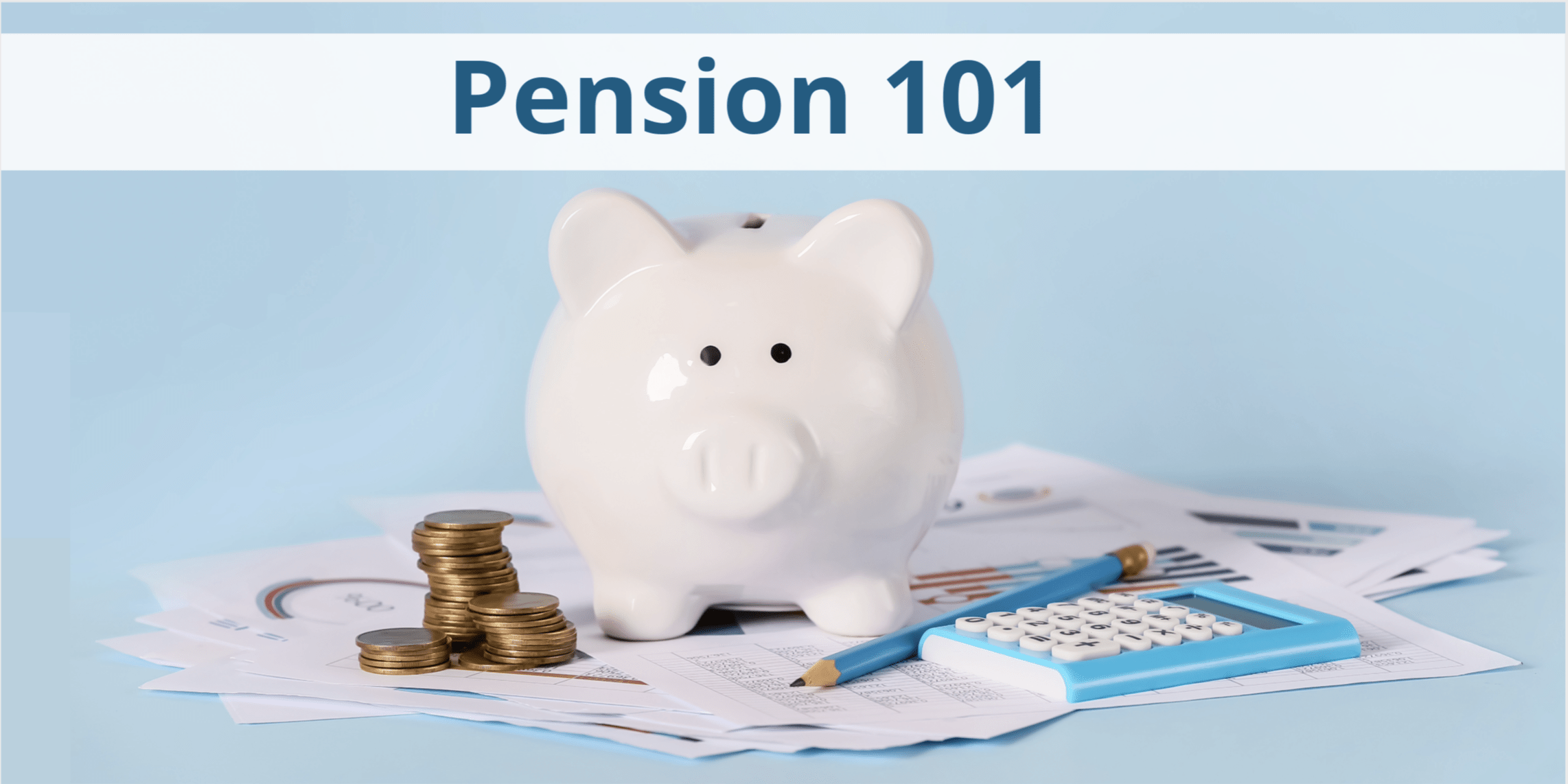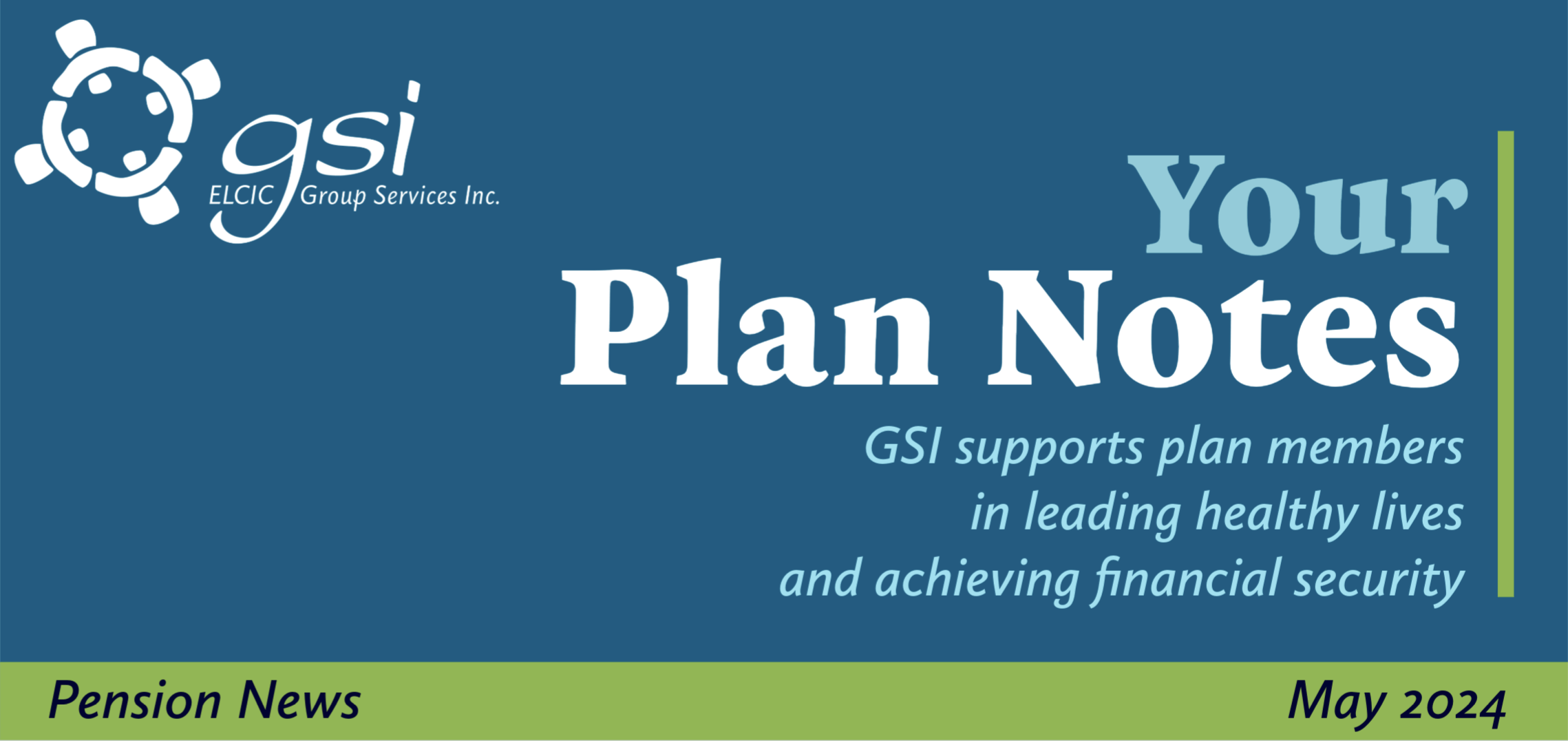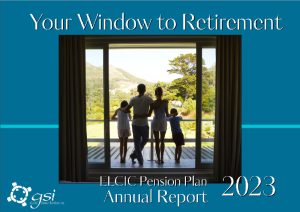
Inflation and Your Pension
There’s no doubt that inflation has impacted everyone over the past couple of years, and that may have pension plan members wondering what this might mean for their retirement. Basic living costs (housing, transportation, groceries, utilities etc.) that once seemed somewhat predictable have become less so. Other necessities such as healthcare costs are rising exponentially as are the prices of our leisure activities such as travel.
A defined contribution (DC) pension, such as the ELCIC Pension Plan, can be very helpful for managing the effects of inflation on the financial resources you will have available in retirement.
Your Pension Account While You Are in the Saving Phase
 A well run DC plan engages knowledgeable investment professionals who manage assets during inflationary (and non-inflationary!) periods. These professionals develop complex ideas and strategies to enhance investment performance and adjust these strategies as markets change. An investment manager may use certain classes of assets1 as a hedge against inflation and actively rotate into sectors that benefit most in an inflationary environment. Experienced active investment management increases the assets in the members’ accounts, ultimately resulting in a larger pension.
A well run DC plan engages knowledgeable investment professionals who manage assets during inflationary (and non-inflationary!) periods. These professionals develop complex ideas and strategies to enhance investment performance and adjust these strategies as markets change. An investment manager may use certain classes of assets1 as a hedge against inflation and actively rotate into sectors that benefit most in an inflationary environment. Experienced active investment management increases the assets in the members’ accounts, ultimately resulting in a larger pension.
Your Pension Account as Retirement Income
When a Plan Member retires (or when they reach age 71), they transfer their funds out of the group pension plan and move it to their financial institution or to a life insurance company.
 The most common choice is to move the member’s account balance into a Life Income Fund (LIF), from which the retiree then draws a monthly retirement income. In a LIF, the account continues to be invested, and the retiree, together with an experienced adviser, uses strategies similar to those mentioned above so they can continue to enhance investment returns and hedge against inflation. In other words, your money keeps working for you, and you can continue to mitigate the effects of inflation in a LIF.
The most common choice is to move the member’s account balance into a Life Income Fund (LIF), from which the retiree then draws a monthly retirement income. In a LIF, the account continues to be invested, and the retiree, together with an experienced adviser, uses strategies similar to those mentioned above so they can continue to enhance investment returns and hedge against inflation. In other words, your money keeps working for you, and you can continue to mitigate the effects of inflation in a LIF.
A popular retirement withdrawal strategy from a LIF is the 4% rule. Following this strategy means that the retiree can withdraw 4% of their account balance during the year they retire, and then the annual withdrawal amount can be increased or adjusted according to inflation each subsequent year for 30 years. This rule is, of course not suitable for everyone and would depend on the retirement strategy of the retiree.2
For many, though, this strategy or a version of it works well, providing the possibility of growing their fund at a rate similar to that of a defined benefit pension (which are generally indexed to inflation), while still providing regular income and often providing some money to the retiree’s heirs after they pass (i.e., a death benefit).
 Another option is to use the DC account to purchase an annuity at retirement. With an indexed annuity, a retiree is guaranteed a certain amount of income each year for the remainder of their life, and this amount will increase over time. With a non-indexed annuity, the initial annual income is higher than the indexed annuity, but it will not increase over time.
Another option is to use the DC account to purchase an annuity at retirement. With an indexed annuity, a retiree is guaranteed a certain amount of income each year for the remainder of their life, and this amount will increase over time. With a non-indexed annuity, the initial annual income is higher than the indexed annuity, but it will not increase over time.
For example, a retiring member at age 65 who can purchase a non-indexed annuity with an income of $2,350 per month for life would alternatively be able to purchase a 2% indexed annuity with an income starting at $2,000 per month and increasing over time.
A third option is to combine a LIF or a non-indexed annuity with an indexed annuity.
Notes
1 Certain classes of assets can be used as a hedge against inflation both during accumulation and during drawdown (retirement); for example, Commodities and Real Estate in periods of high inflation and high growth, and Inflation protected bonds and gold in periods of high inflation and low growth.
2 Examples of cases for which this rule may not suit: (a) For retirees who may wish to eliminate some debt at the start of retirement, but will have other income coming in from other sources afterwards; (b) for a retiree who has additional capital later in retirement (house, inheritance, large TFSA) and who may wish to draw more than 4% earlier in retirement; this may also tie into taxes where you are trying to draw out taxable income at the lowest brackets.
Questions and Answers
Would a defined benefit (DB) or target benefit (TB) pension plan provide greater inflation protection than I would have after converting my DC pension account to a LIF?
As mentioned above, a LIF can be designed to function similarly to an indexed DB/TB pension. So, if a retiree (with an adviser) has invested wisely, the pension income should have similar inflation protection to an indexed DB/TB pension.
There are many other advantages to a DC plan over a DB/TB plan. For example,
 flexibility in retirement on the amount of income the retiree wishes to spend,
flexibility in retirement on the amount of income the retiree wishes to spend, - the option to leave an estate for heirs of the retiree’s choice (may include a registered charity or people other than a spouse),
- the ability to split the pension into a secure indexed or non-indexed annuity and have a LIF withdrawal,
- all the positive returns earned when the markets perform well remain in the member’s account and later the retiree’s LIF, which is not the case in DB/TB plans,
- inequities that may arise due to sharing between generations or inequality due to longevity are not present in DC plans as it is in DB/TB plans; in other words, the account balance made up of contributions and investment returns belongs solely to the plan member.
Do you really need the inflation protection of a secured indexed annuity or DB/TB pension?
Having an inflation-protected pension may not be beneficial to all members, especially members who do not live many years after they retire (whether due to failing health or to an accident). This group may not see the full potential of their pension value accrued in retirement with a secured indexed annuity. A person with a shorter life expectancy may wish to draw down their pension sooner, so they enjoy their shortened retirement as much as possible.
 Many factors determine what type of pension (DC, DB, TB) would be “best” for a given individual. For ELCIC Pension Plan Members, the most important thing to remember is that you have an employer-sponsored pension plan and are therefore ahead of the large number of Canadians who do not enjoy that privilege.
Many factors determine what type of pension (DC, DB, TB) would be “best” for a given individual. For ELCIC Pension Plan Members, the most important thing to remember is that you have an employer-sponsored pension plan and are therefore ahead of the large number of Canadians who do not enjoy that privilege.
Retirement is a major life change, so we encourage you to start thinking about it sooner rather than later. You may wish to make voluntary contributions to the ELCIC Pension Plan or to your own RRSP/TFSA to enhance your retirement benefits. This will go a long way to reduce stress, since retirement should be about the things you love to do, while still being paid.

The 2023 Annual Report is Here!
GSI is pleased to release the 2023 ELCIC Pension Plan Annual Report. Here’s a brief introduction from the Board Chair, John Wolff:
The Annual Pension Plan Report for 2023 is presented with the theme of windows, a metaphor that is appropriate in several ways. When we are looking through a window, we can see the possibilities that exist beyond our current setting. This view is framed by the sill and slightly obscured by the glass; it is not a complete picture, as we might have if we were actually out in the environment.
Likewise, this Report presents a specific, one-year view of the ELCIC Pension Plan. This view can be very helpful for projecting into the future when Members will access their pensions — but the amount that will be available at retirement will depend on many factors and multiple years of investment results.
Read more in the 2023 Annual Report

GSI at Your Synodical Gathering in 2024
2024 is a year for Synod Conventions/Assemblies, and GSI will be there! Staff and Board Directors are planning to be present and are looking forward to meeting you and other Plan Members there.
 Have you noticed an HRV reading on your smartwatch and wondered what it means? Or wished you could find ways to feel less stressed? As part of our ongoing effort to promote wellness in the ELCIC, we will be having a HeartMath® practitioner at our display. The HeartMath Institute has done research to show how heart rate variability (HRV) is tied to your health, your biological age, and your stress levels. Using special equipment, the practitioner will be able to measure your HRV and explain what this tells you about your health and emotions.
Have you noticed an HRV reading on your smartwatch and wondered what it means? Or wished you could find ways to feel less stressed? As part of our ongoing effort to promote wellness in the ELCIC, we will be having a HeartMath® practitioner at our display. The HeartMath Institute has done research to show how heart rate variability (HRV) is tied to your health, your biological age, and your stress levels. Using special equipment, the practitioner will be able to measure your HRV and explain what this tells you about your health and emotions.
If you’re a Plan Member, you are invited to check out the display (and pick up a cool GSI packable shopping bag!) whether or not you are a delegate to the convention/assembly.
Learn more about the science of HeartMath on the HeartMath Institute’s website.
HeartMath® at Your Synodical Gathering
Dates are probable but subject to change. It is anticipated that the person will be at the display from 9:30 am – 3:30 pm.
MNO (Selkirk, MB): May 25 (new date)
SK (Saskatoon, SK): May 31
Eastern (Mississauga, ON): June 21
BC (Vancouver, BC): June 21
ABT (Edmonton, AB): June 23
Measuring HRV only takes a couple of minutes, so no appointments are required. The practitioner will also be at the display during less busy times for those who wish for a more in-depth discussion about how improving HRV can reduce stress.

2024 is Off to a Great Start!
This year, 2024, is off to a good start, with the first quarter bringing in positive investment returns for the ELCIC Pension Plan. The global equity portfolios did particularly well as they continued the trend from the last quarter of 2023.
 Last quarter, we mentioned that the technology stock performed particularly well and was the best performing sector. This has broadened out to a few other sectors as economists predict a recession will be less likely, inflation has fallen significantly, and other issues such as supply chain problems have resolved. Global equity markets did particularly well, having their best quarter since 2020.
Last quarter, we mentioned that the technology stock performed particularly well and was the best performing sector. This has broadened out to a few other sectors as economists predict a recession will be less likely, inflation has fallen significantly, and other issues such as supply chain problems have resolved. Global equity markets did particularly well, having their best quarter since 2020.
Details for each fund and for each quarter compared to a benchmark can be found below. Top ten stocks for each portfolio can be found on the GSI website.
ELCIC Pension Plan
| ELCIC Pension Plan Investment Return | Median Balanced Pension Plan as a comparison | Excess return | |
|---|---|---|---|
| Jan 1 to Mar 31, 2024 | 4.9% | 4.8% | 0.1% |
Growth Fund
Here is a closer look at each portfolio within the Growth Fund.
PH&N Canadian Equity Value Fund
| PH&N Canadian Equity Investment Return | S&P/TSX Capped as a comparison | Excess return | |
|---|---|---|---|
| Jan 1 to Mar 31, 2024 | 6.8% | 6.6% | 0.2% |
This fund had another strong performance this quarter earning 6.8%, which was ahead of the S&P/TSX index of 6.6%. A significant contributor to this result was PH&N’s selections in the Energy sector. This fund is actively managed and PH&N made a number of adjustments as circumstances evolve and opportunities come to light.
RBC Global Equity Focus Pension Trust
| RBC Global Equity Investment Return | MSCI World ($CAD) as a comparison | Excess return | |
|---|---|---|---|
| Jan 1 to Mar 31, 2024 | 12.7% | 11.9% | 0.8% |
The momentum from 2023 continued in this quarter, which posted a result of 12.7%, a full 1.0% above the benchmark of the MSCI World index. Information Technology continued to lead in providing the best returns, along with the Consumer Discretionary sector.
Baillie Gifford Global Equity Fund
| Baillie Gifford Global Equity Investment Return | MSCI World as a comparison ($CAD) | Excess return | |
|---|---|---|---|
| Jan 1 to Mar 31, 2024 | 10.5% | 11.9% | -1.4% |
This global equity fund also had a great return this quarter at 10.5%. Again, with the technology sector leading the returns, a significant portion of this portfolio has investments in companies that are developing and using Artificial Intelligence.
This fund made a new investment in a healthcare company called Novo Nordisk. This Danish pharmaceutical company has developed a new weight loss drug that according the Baillie Gifford is “experiencing extraordinary demand … as the world is only in the early stages of seeing obesity as a treatable disease, and the potential patient population is enormous; there are around 800 million obese people in the world today.”
Baillie Gifford has also been doing some ‘spring-cleaning’ and making several adjustments to sell stocks where the performance is not as expected and moving to opportunities that appear poised for growth.
Fixed Income Fund Results
Here are the results of the Fixed Income portfolios.
PH&N Core Plus Bond Fund
| PH&N Core Plus Bond Fund Investment Return | FTSE Canada Universe Bond as a comparison | Excess return | |
|---|---|---|---|
| Jan 1 to Mar 31, 2024 | -1.0% | -1.2% | 0.2% |
PH&N Mortgage Pension Trust
| PH&N Mortgage Pension Trust Investment Return | FTSE CanadaShort-term Bond as a comparison | Excess return | |
|---|---|---|---|
| Jan 1 to Mar 31, 2024 | 0.7% | 0.3% | 0.4% |
PH&N High Yield Mortgage Fund
| PH&N High Yield Mortgage Investment Return | FTSE Canada Short-term Bond as a comparison | Excess return | |
|---|---|---|---|
| Jan 1 to Mar 31, 2024 | 1.7% | 0.3% | 1.4% |
Please note that this information is not intended to be investment advice or to be a recommendation for your personal investment portfolio. The content is intended for information purposes only and should not be disclosed to other third parties or used for the purposes of market timing or seeking to gain an unfair advantage.

We welcome your questions & feedback!
please write to us: admin@elcicgsi.ca
or call toll free: 1-877-352-4247 (in Winnipeg 204-984-9181)
information and resources can also be found on the GSI website


